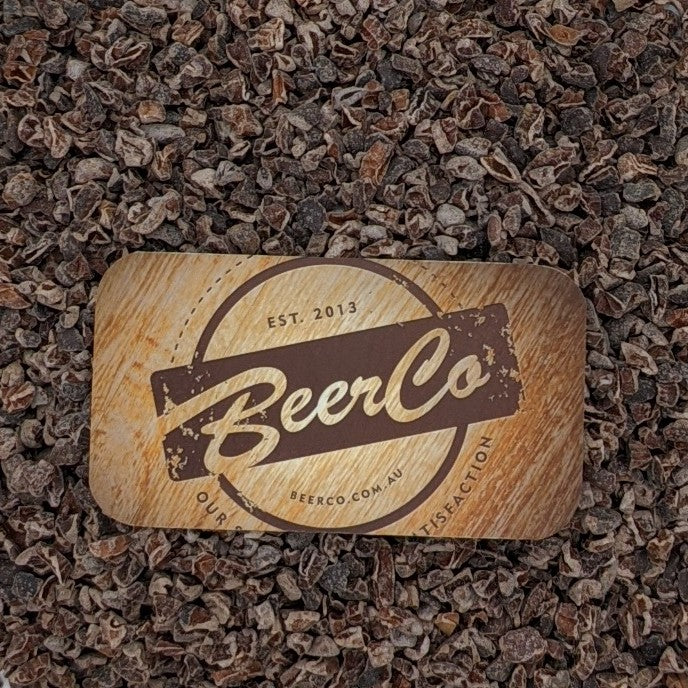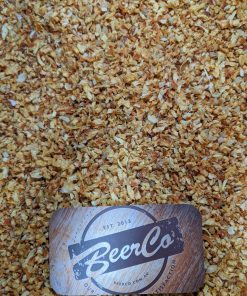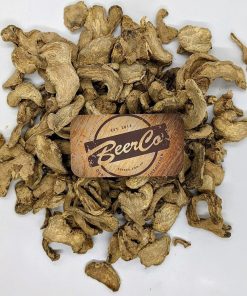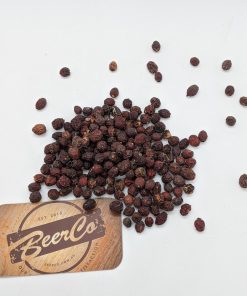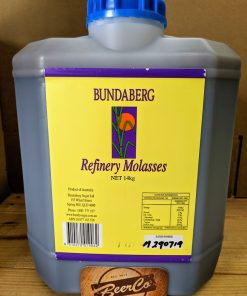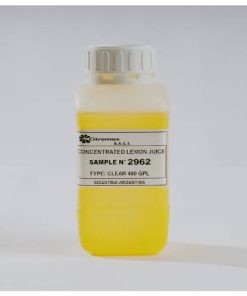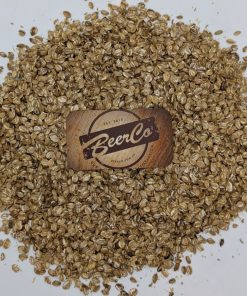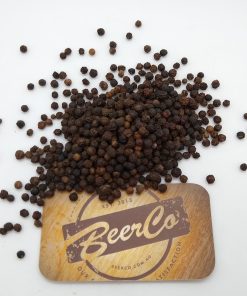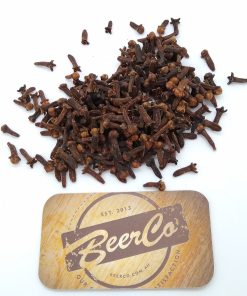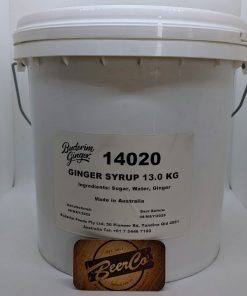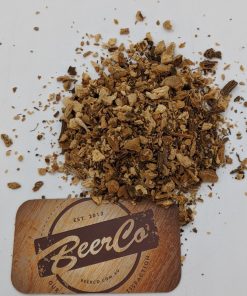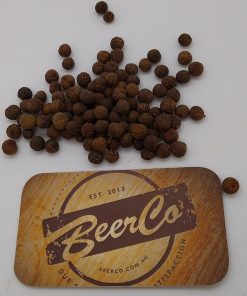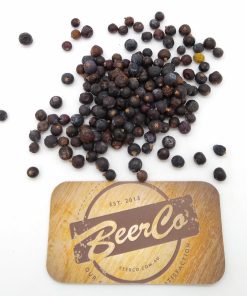Organic Cacao Nibs Maretai Organics
$ 4,95 $ 2,97
Cacao nibs (sometimes mistakenly called cocoa nibs) are dried and fermented cacao seeds that have been chopped into pieces. They are bitter and nutty, and have a texture similar to roasted coffee beans. BeerCo.au proudly stock Single origin Criollo cacao bean fragments. Botanical Name – Theobroma Cacao.
Snapshot
- Organic Certified
- Gluten – Free
- Vegan
- Kosher Certified
- GMO Free
Our Cacao nibs are sourced from Peru where cacao grows natively. Several groups of organic farmers, forming a cooperative, cultivate the premium criollo Theobroma Cacao in its native environment. These farmers have received training on how to cultivate the Cacao using only organic farming techniques without the use of pesticides or chemical fertilizers.
The beans are extracted from the inside of the Cacao fruit which contains both the beans (seeds) and a white pulp. The beans are separated from the pulp and left to ferment for 6-7 days. After fermentation, the beans are dried in the sun for 3-4 days, after this, they then go through a cleaning process.
The Cacao Beans are then husked, broken into fragments and separated from impurities such as small stones and husk fragments. The Cacao Nibs have the same nutritional value as the Cacao Beans and Cacao Paste.
Cacao nibs are arguably the easiest forms to use for brewing. Cacao nibs are cocoa beans that have been fermented, dried, roasted, and hulled: the first steps on the way to becoming chocolate. Coarsely crush cacao nibs as you would specialty grains before use.
Crushed cacao nibs may be added to the mash, the boil kettle (again, knockout is best), or to the secondary fermentor for a couple of weeks. Start with 4 ounces (113 grams) per 5 gallons (19 liters) of homebrew.
Pack Sizes:
- 100g
- 250g (SAVE 20% OFF 100g Price)
- 500g (SAVE 27% OFF 100g Price)
- 1Kg (SAVE 10% OFF 100g Price)
- 15 Kg (SAVE 15% OFF 1Kg Price)
FAQs:
Why are there some small shells found in my nibs?
Due to the nature of the product, a small amount of shell fragments may be found. You need to be careful and separate these.
Can I eat cacao nibs directly from the bag?
Yes, like everything you need to eat with moderation. You can use as a superfood snack although you may find they are strong and bitter. You can use as natural chocolate chips in brewing, baking and ice cream.
What’s the best storage condition?
Keep the nibs in a cool dry place.
BeerCo All Grain Recipe Kits featuring Cacao Nibs:
- Starstruck | Chocolate Milk Stout
Sources of Knowledge and further reading on Brewing with Chocolate:
- BYO | Brewing with Chocolate: Tips from the Pros
Brewer: Wayne Wambles from Cigar City Brewing in Tampa, Florida
My personal preference is always single origin cacao nibs that have been winnowed and lightly roasted.
I prefer to add cacao nibs to secondary, using recirculating infusion to hit my target aroma/flavor. We use a separate vessel that keeps the nibs out of the fermenter or bright tank. The nibs are added to the infusion vessel and the beer is recirculated through that vessel and back into the fermenter/bright tank until we feel we have achieved the desired impact. Once we hit our target, we push the remaining beer out of the infusion vessel and back into the fermenter/bright tank with CO2. This process creates a homogeneous mixture of beer and chocolate, allowing us to understand where we are in the infusion process. It also expedites the infusion process vs static infusion. Static infusion can also stratify, making the level of infused chocolate less apparent.
If you can design a recirculating infusion device, you will not only save time infusing the chocolate but you will usually be able to use less with better aroma/flavor results. Be careful with infusion contact time and usage rate. If you go too far, you will end up with some undesirable astringency. When it comes to quantity, it all depends on the desired impact. Targeting a range of 0.5–1.25 lbs. (230–570 g) of cacao nibs per barrel of beer is a good range. If it’s a darker, higher gravity beer, it’s best to lean towards more volume per barrel.
Make sure that there are ample crystal malt additions and/or residual sweetness (higher terminal gravity) in beers that you plan on using higher volumes of chocolate to combat astringency. This can be partially controlled by implementing higher mash temperatures too.
Be careful with cocoa powder usage versus cacao nibs. High levels of cocoa powder usage can create a chalky character in beer that leaves an unpleasant mouthfeel in the finish. Cacao nibs can increase mouthfeel of beer. If you are light in body prior to the addition, this can help. If you are targeting a lighter body, you might have to slightly adjust mash temperatures in order to account for the slight increase in body from the cacao nib usage rate.
I primarily focus on porters and stouts for chocolate infusion but brown ales and dark mild ales could benefit from the use of chocolate as well. Depending on intent and desired aroma/flavor impact, chocolate could be used in lighter styles too.
Brewer: Chris Mayne from Northshire Brewery in Bennington, Vermont
To get the chocolate intensity you want, start with dark crystal malts then add healthy amounts of chocolate malt and/or dark chocolate malt. Use up to 10% chocolate malt of total grain bill. Higher mashing temps help with sweetness but can also strip some undesirables from dark malts. Adding roasted barley and black malts later in the mash can help reduce these astringent gremlins. You can add cocoa nibs in the mash it will give subtle cocoa flavors. The boil is when you want to add solid chocolates. I like using high percentage cocoa chocolates, 92-94%. Grating the chocolate will help it dissolve into the solution. After active fermentation we add cocoa nibs. I run the nibs through the autoclave before adding to the fermenter but a pressure cooker will also work. Keeping lots of notes, especially sensory panels, will help you fine tune your recipe.
Although many homebrewers use commercially available cocoa powder, chocolate bars, or syrups, commercial craft brewers tend to focus on the use of the cacao nibs (chopped beans) themselves. Cacao beans contain fat and, when separated from cocoa solids, this is referred to as cocoa butter. Many commercial chocolate preparations contain cocoa butter, which is of interest to brewers because fats and oils have deleterious effects on foam formation and retention. Depending on many factors, including the means of addition and the fermentation profile, fats may or may not survive into the finished beer. Almost all commercial chocolate contains sugar; other common ingredients are vanilla, peanuts, and milk powder.
Those wishing to retain purer flavors will stick with straight cacao or with baker’s chocolate. Either can be added to the boil. Another popular method is to age beer on cacao nibs postfermentation. This avoids fat extraction and gives a true cacao flavor and aroma, including fruity elements that can be lost in the production of commercial chocolate. Cacao beans, however, also contain considerable amounts of bitter tannin, and long contact times with beer can leach these astringent compounds out along with other flavors. As with other flavorings, alcohol-based extracts are available, but better producers generally avoid them. Used well, various forms of chocolate can add pleasant notes to porters and stouts, but brewers have added chocolate to many other beer styles with varying success. Some of the most interesting pair the chocolate character with sweet spice and/or chili flavors that recall ancient Mesoamerican drink preparations and currently popular forms of Mexican drinking chocolate.
Fountain, Henry. “Love of chocolate may have begun with cacao beer.” The New York Times, November 13, 2007 (accessed December 11, 2010).
| Size | 100g, 250g, 500g, 1 Kg, 15 Kg |
|---|
Fast shipping and professional packing
We offer a wide range of shipping options due to our long-running partnerships with UPS, FedEx and DHL. Our warehouse staff are highly trained and will package your items according to our precise and precise specifications. Before shipping, all goods are thoroughly inspected and securely secured. Every day we ship hundreds of packages to our customers from all over the world. This is a sign of our commitment to be the largest online retailer worldwide. The warehouses are located situated in Europe as much as they are in USA.
Note: Orders containing multiple items will have a different processing period for each item.
Before shipping the items, our staff will carry out an extensive inspection of the products you have ordered. The majority of orders are delivered within 48 hrs. The delivery time should be between 3-7 working days.
Returns
We don't manage the stock in our factory and warehouse. Actual stock levels may fluctuate at any moment. Be aware that it's possible that your order will be out of stock after you have placed the order.
Our policy is for 30 days. Unfortunately, if 30 days have passed from the date you purchased the product, we are unable to offer you a return or exchange.
The item must not be used, and it must be in the original packaging. It must also be in the original packaging.
Related products
Adjuncts
Adjuncts
Adjuncts
Adjuncts
Adjuncts
Adjuncts
